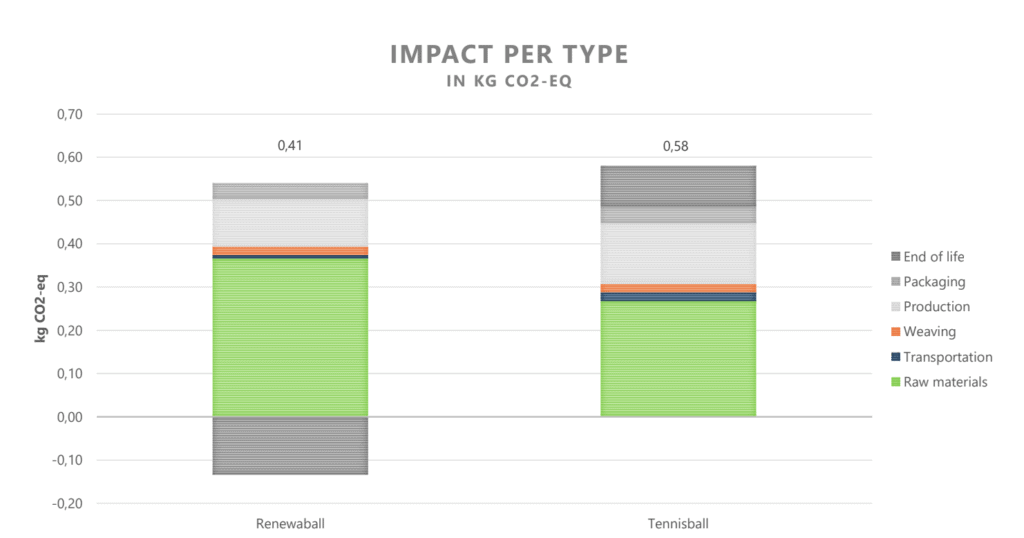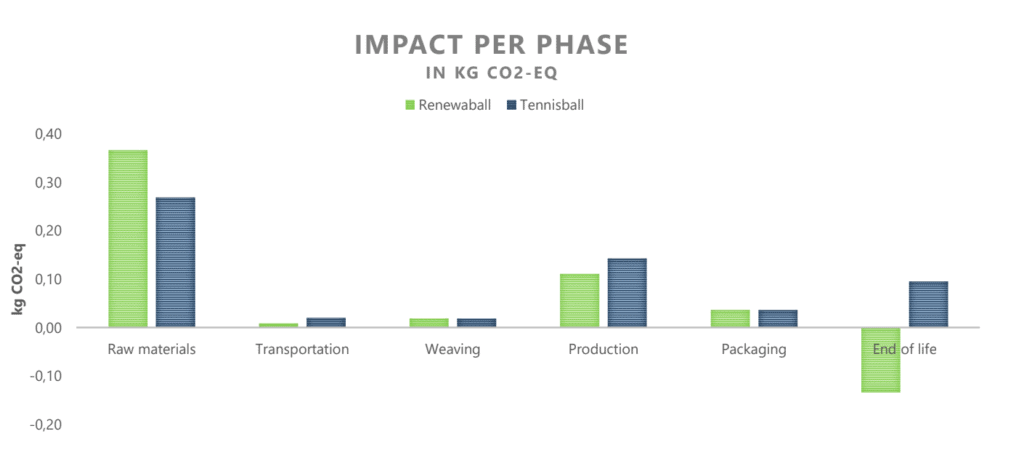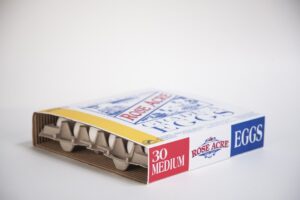Positive environmental impact can be achieved through even the smallest of items- especially if the sum of these items is significant. This is exactly the case when it comes to tennis balls. Annually, 5,5 million Dutch tennis balls end up in incinerators. Imagine the positive effect if those 5,5 million tennis balls would be properly recycled.
Meet the responsible tennis ball
Renewaball is the first tennis ball that’s made from recycled tennis balls. Therefore, it can be seen as quite a milestone regarding circular innovation within the sports industry.
Renewaball collects these old tennis balls with collection bins at several tennis courts. The placing of these collection bins and the use of the Renewaballs is an initiative encouraged by- and initiated in the World Tennis Tournament Rotterdam Ahoy (2021) and their head-sponsor ABN AMRO.

How it works
The Renewaball uses an innovative process that takes apart used tennis balls into clean, separate parts of felt and rubber which are used for the production of the Renewaball.
Where a traditional tennis ball does not contain any recycled material, the Renewaball is made out of >30% recycled material.
And the best part: not only their own Renewaballs are recycled, but also traditional tennis balls are being collected and re-used. Win-win right?

The Environmental Impact of Renewaball
Renewaball already knew that sustainability was at the heart of their products- but wanted the actual data to prove it. They wanted to measure and compare the Renewaball’s environmental impact compared to that of a regular tennis ball.
Methodology
A comparative Life Cycle Assessment (LCA) was performed for the Renewaball and the ‘business as usual’ alternative in Ecochain’s product LCA tool Mobius. Primary data was used for the production impacts and EcoInvent served as the primary secondary data. The results showed Renewaball’s main impact reduction points compared to a regular, 0% recycled tennis ball.
Results
The LCA showed that the environmental footprint of a Renewaball was significantly lower than that of a regular tennis ball. To be specific- 29% lower.
With a footprint of 0,41 kg *CO₂-eq, the Renewaball has an impact reduction of 0,17 kg CO₂-eq compared to that of a regular tennis ball with 0,58 kg CO₂-eq (Image 2).
*CO₂-eq = carbon footprint

The biggest changemaker: A take back system
The biggest impact reduction point when comparing the Renewaball with a regular tennis ball is the recycling process of the used Renewaballs that are collected through a take back system (End of life phase).
We already know that recycling is very important. But when it comes to Renewaball it entails a significant impact reduction of at least 0,134 kg CO₂-eq per Renewaball (image 4) compared to the incineration process of a regular tennis ball.

Transportation
Where a traditional tennis ball uses wool from New Zealand that is transported to England. The Renewaball uses wool from Norway and the United Kingdom.
Because of this decision- the distance for retrieving materials for a regular tennis ball is on average 6 times more than the distance for materials used for the production of the Renewaball.
However, although this is a large difference in transportation distance, this doesn’t have a large significant effect on the Renewaball’s overall impact reduction (>1%), as can be seen in image 3 and 4.
Raw materials
The biggest environmental impact hotspot for the Renewaball is its raw materials which account for nearly 70% of their total environmental impact (image 3).
And that’s because the main ingredient for the Renewaball is wool (86%). The reason for this high impact is that just like other livestock, sheep cause a high Greenhouse Gas (GHG) impact, mainly related to methane emissions.
Renewaball is making a conscious tradeoff to reduce microplastics related to Nylon -which is not present in the Renewaball- and the increased GHG emissions due to the higher wool content. In the future, Renewaball wants to use recycled wool to further reduce the GHG impact related to wool.
The future is bright
Now that Renewaball understands its environmental footprint, we can safely say that the Renewaball is good news and holds a bright future. It initiates sustainable change and impact in the sports industry by offering tennis players an alternative, more sustainable option to play with.
Remember when we said, “Imagine the positive effect if those 5,5 million tennis balls would be properly recycled?”. Well, with the Renewaball you would have an impact reduction of 0,17 kg CO₂-eq per ball (0,1764 not rounded off).
So, let’s do the math. 5,5 million tennis balls x 0,1764 kg CO₂-eq = 970.200 CO₂-eq reduction per year.
Seems like a great sustainable way to play your favorite sport.




